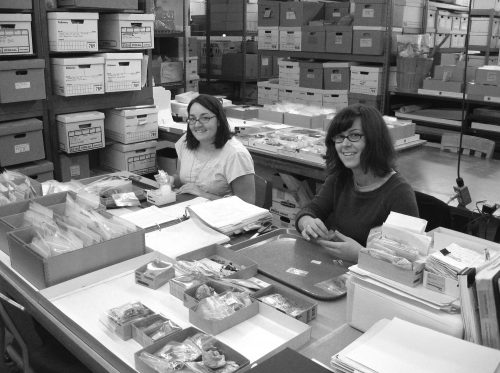The National Endowment for the Humanities (NEH) has awarded a grant to Bill Marquardt and Karen Walker to preserve and organize the world’s largest systematic collection of Calusa Indian artifacts and environmental specimens.

Materials excavated from the Pineland Site Complex between 1988 and 1995 comprise more than 140,000 specimens recovered by hundreds of volunteers and students under Bill and Karen’s supervision, along with Donna Ruhl’s.
Now the home of the Calusa Heritage Trail, the Pineland site has been inhabited for 2,000 years. By the time the Spaniards arrived in the early 1500s, the Calusa Indian people controlled all of South Florida from their homeland on the southwest Florida coast. Pineland – then known as Tampa – was the second largest of all the Calusa towns.
The Pineland Calusa collection is made up of artifacts, environmental specimens, and associated archaeological records. Artifacts include Native American pottery sherds; tools and decorative objects made of shell, bone, shark teeth, and stone; Spanish-derived glass, metal, and ceramic objects; and waterlogged wood, seeds, and other organic materials. Oxygen-free waterlogged areas of the Pineland site preserved the only known prehistoric papaya seeds ever found in North America, as well as the only prehistoric chile pepper seeds known for the eastern United States. The seeds are un-charred, and are about 1900 years old.
The $284,504 NEH grant will fund the curation of materials that resulted from five major field seasons at Pineland (1988, 1989, 1990, 1992, and 1995) as well as 18 linear feet of associated records. Museum staff will rehabilitate the collection by rehousing artifacts, specimens, and samples using an archival bagging and boxing method that will maintain physical order by catalog number and provenience.
The Pineland collection is the largest systematic collection from a major Calusa town site. Pineland’s long period of occupation and the collection’s broad range of extensively documented materials mean that even its smallest elements are in great demand by researchers. Much of the collection is still unanalyzed. Many possible theses and dissertations are waiting to be discovered in this collection. Its rehabilitation will greatly enhance both its research and educational value.
What is “Curation”?
The word curation comes from the Latin word curare, meaning “to care for.” In the museum context, it means taking care of museum collections so that they will be available for study by scholars and students and for museum exhibitions when needed. Museums keep collections of artifacts and other materials (bones, shells, plant remains, sediment samples, etc.) in dust – and acid-free containers, so they will be protected from deterioration, and house them in secure, climate-controlled conditions.
We also keep the documents that relate to the collections, such as field notes, maps, photographs, and other data. These paper records are invaluable aids when one analyzes, or re-analyzes the collections. Finally, like libraries, we maintain a catalogue – a systematic listing of what is in the collections and where the materials are located.
The Florida Museum of Natural History, of which the Randell Research Center is a part, is the largest collections-based museum in the southeastern U.S., and it is Florida’s official natural history museum. The new NEH grant will help us curate the Pineland artifacts and records to the highest standards, greatly enhancing their long-term usefulness
This article was taken from the Friends of the Randell Research Center Newsletter Vol 6, No. 4. December 2007.